Introduction
So far, we have studied BJTs and their different configurations, isolated from any other circuitry. We’ve learned a lot, and we’re much further along than we first started. However, until now we haven’t given much thought as to our circuit’s frequency response, and how differently that can behave depending on our input signal’s frequency.
High Frequency Models
If we stick to our low-frequency transistor model, we won’t see anything particularly worrisome when increasing our input frequency. But that model doesn’t give us the whole picture, even if it is an acceptable approximation for lower frequency signals. For RF design however, this model isn’t enough, and we’ll need to introduce the transistor’s imperfections into the mix to appropriately predict a circuit’s behavior at higher frequencies. Let’s take a closer look at our bipolar junction transistor:
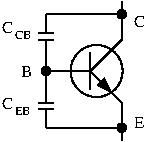
In reality, you have parasitic capacitance’s between Base and Emitter, and between Base and Collector. This is not intentional, but rather an unavoidable artifact from the manufacturing process. A simple way to understand this parasitic capacitance is to look back at our PN junction.
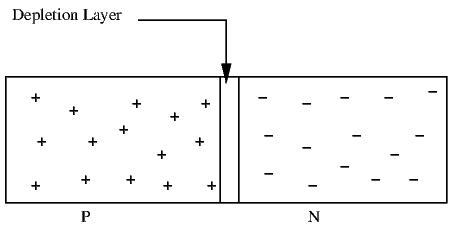
There is an accumulation of charge at this junction, and thus this junction exhibits capacitance. We have 2 PN junctions in BJT, so we have 2 parasitic capacitance’s. They are very low, on the order of a few picofarads. Remember that a capacitor’s impedance is ![]() . At low frequencies,
. At low frequencies, ![]() is very low, so this parasitic capacitance can be safely ignored. At higher frequencies however, they can start altering our circuit’s behavior. To better quantify this effect, let’s introduce the transistor’s high-frequency model, also called the hybrid-pi model:
is very low, so this parasitic capacitance can be safely ignored. At higher frequencies however, they can start altering our circuit’s behavior. To better quantify this effect, let’s introduce the transistor’s high-frequency model, also called the hybrid-pi model:

In the above model, ![]() . Let’s apply an input signal and try to determine the current gain of the amplifier. We want to see if it still
. Let’s apply an input signal and try to determine the current gain of the amplifier. We want to see if it still ![]() . Let’s find an expression for
. Let’s find an expression for ![]() and
and ![]() and find the ratio.
and find the ratio.
For ![]() , we short the collector output and find:
, we short the collector output and find:
![]()
![]()
![]()
And now for ![]() , we find:
, we find:
![]()
![]()
![]()
We can now derive our current gain ![]() :
:
![]()
![]()
To make sense of this equation, let’s give some actual numbers for these values:
Knowing this, we can simplify our above equation:
![]()
We can simplify this equation further by remembering that ![]() .
.
So, our current gain becomes:
(1) ![]()
Note that our current gain is frequency-dependant!
If you’ve studied a little bit of control theory, you’ll recognize a first order transfer function:
![]()
with ![]()
We can define a bandwidth ![]() . BJTs have bandwidth! We can also get the transistor’s current gain depending on the signal frequency:
. BJTs have bandwidth! We can also get the transistor’s current gain depending on the signal frequency:
- for low frequencies:

- for high frequencies:

So
An important characteristic of a transistor is its gain-bandwidth product ![]() . It represents the frequency at which gain is unity. Here, gain is unity when
. It represents the frequency at which gain is unity. Here, gain is unity when ![]() .
.
We can express the high frequency current gain with the following equation:
![]()
The gain-bandwidth product is a fundamental characteristic for higher frequency circuits, and is available in every datasheet.
Altered Circuit Behavior at Higher Frequencies
With that out of the way, let’s see how these extra capacitance’s can hinder our designs. We’ve seen that our current gain decreases with frequency, but we’re still able to have huge bandwidth right? The gain-bandwidth product for the common 2N3904 NPN transistor gives us ![]() (remember
(remember ![]() ). This is the frequency at which our current gain is unity (the transistor can no longer amplify). So, if we want to have a gain of say, 50, then our bandwidth would be
). This is the frequency at which our current gain is unity (the transistor can no longer amplify). So, if we want to have a gain of say, 50, then our bandwidth would be ![]() . Unfortunately, it isn’t that simple, and depending on how we exploit our transistors, we can end up having a drastically lower bandwidth.
. Unfortunately, it isn’t that simple, and depending on how we exploit our transistors, we can end up having a drastically lower bandwidth.
Let’s take a look at our CE amplifier again, this time adding ![]() and
and ![]() :
:
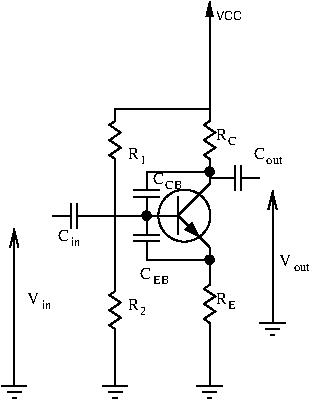
For a capacitor: ![]()
So here, ![]() (remember that the CE amplifier is an inverting amplifier.
(remember that the CE amplifier is an inverting amplifier.
Let’s inject this into our capacitor charge formula:
![]()
Notice that in this equation an apparent capacitance ![]() appears. The voltage drop across CB increases the apparent capacitance and hinders high frequency performance. Bandwidth is reduced by a factor of
appears. The voltage drop across CB increases the apparent capacitance and hinders high frequency performance. Bandwidth is reduced by a factor of ![]() . This is the Miller Effect. Keep in mind that
. This is the Miller Effect. Keep in mind that ![]() doesn’t change, but that with high voltage drop its acts like a
doesn’t change, but that with high voltage drop its acts like a ![]() times bigger capacitance.
times bigger capacitance.
The Miller Effect in Other Circuits
Not all transistor amplifier configurations suffer from this effect. To understand why, let’s do the calculations for the CB amplifier and the CC amplifier.
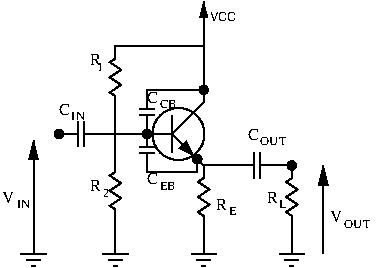
Here we have:
![]()
![]()
Since there is very little voltage drop between ![]() and
and ![]() :
:
![]()
No Miller Effect for the CC amplifier. There is very little voltage drop between collector and base.
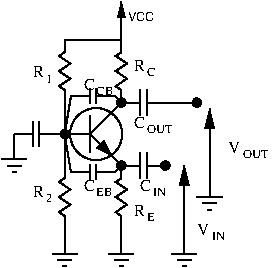
For the CB amplifier:
![]()
![]()
The base is grounded, there is no Miller Effect.
Conclusion:
Out of the three BJT amplifier configurations, only the CE amplifier suffers from the Miller Effect. However, this doesn’t mean we’re limited to CC and CB amplifiers for HF work. CE amplifiers CAN be used for high frequency circuits, you just need to be mindful of the limitations, and that your bandwidth will be restricted.
The Miller Effect doesn’t apply to just BJT amplifiers. All inverting amplifiers suffer from it.
To get around the Miller Effect, a special configuration can be used. In the next chapter we’ll talk about the cascode amplifier.